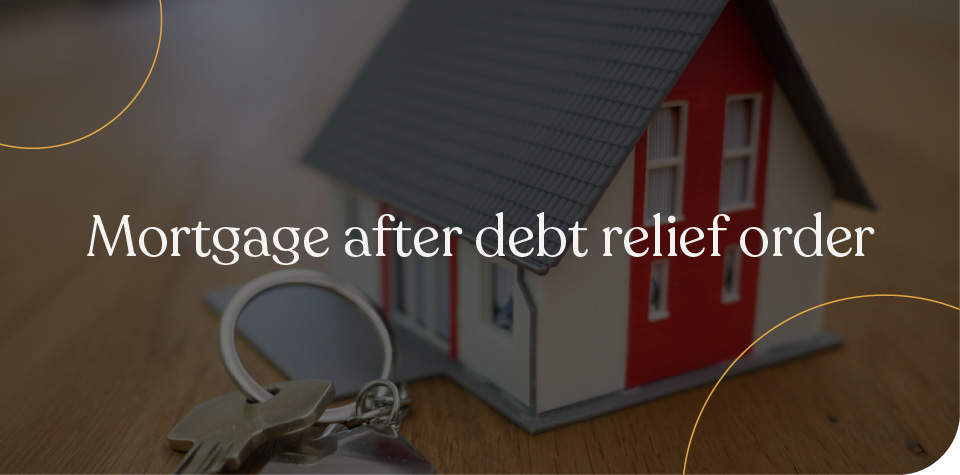
Can you get a mortgage after debt relief order in the UK?
A debt relief order (DRO) can be a great solution for anyone dealing with debt. It prevents creditors from taking further enforcement action against you, such as fees and interest on outstanding balances. It gives you a chance to breathe and return to the drawing board.
These restrictions are not indefinite, though. Debt relief orders can only be in effect for 12 months but will still appear in your credit history for six years. This makes it difficult to apply for a mortgage after debt relief order.
Can you get a mortgage after a DRO? How should you go about mortgage approval?
How do you qualify for a mortgage after debt relief orders? This guide explores the answers to these questions and more. Read on.
Use our online mortgage calculator as a guide for your monthly repayments now
We have access to over 200 lenders in the UK to get you the best ratesWe are expert mortgage brokers
Jump to:
Is it possible to get a mortgage after a debt relief order?
The short answer is yes, although it might not be as straightforward as expected. A debt relief order limits your ability to borrow and incur more debt for about 12 months.
This means that for the duration the DRO is in effect, you will not be able to get a mortgage, personal loan, or any other form of credit financing.
Once you are discharged, the restrictions on your ability to borrow will be lifted, and you can apply for a mortgage. However, the DRO and any unsatisfied financial obligations will remain on your credit file for six years. Any debts you have paid off will be erased from your credit report once the 12-month discharge period elapses.
Mainstream lenders don’t generally approve mortgage applications from prospective borrowers with a DRO in their credit history. A DRO in your credit history will make it harder to secure a mortgage, but it doesn’t preclude you from getting one. You need to know where to look and how to go about it.
On the other hand, speciality lenders will consider your mortgage application if the DRO isn’t recent and you have a reasonable explanation for why you got it in the first place.
The best way to access these speciality lenders is through a bad credit mortgage broker. They are well-versed in helping individuals with adverse credit histories secure mortgages.
Eligibility requirements when applying for a mortgage after a debt relief order
What do lenders look for when deciding whether to approve mortgage applications from individuals with DROs in their credit history? Below is a list of criteria most mortgage lenders use to vet prospective borrowers.
Reason for the DRO
The first thing lenders are interested in is how the DRO came about in the first place. They analyze applications on a case-by-case basis when determining whether or not to approve you for a mortgage.
A reasonable explanation for how you came to be in so much can be something along the lines of income loss due to the pandemic or severe illness. A mortgage lender would be more inclined to grant you a mortgage on that basis as opposed to the root cause being general financial delinquency.
Period since discharge
A DRO will remain in your credit record for six years. Different lenders have different post-discharge waiting periods during which they will not consider mortgage applications from borrowers with a DRO in their credit file.
Depending on the provider, this post-discharge duration can be anywhere from 1-6 years. You can use this period to work on fixing your credit to improve your chances of getting approved.
Credit history since discharge
Most lenders would expect a clean credit history post-discharge if you had a DRO. This means that you shouldn’t have any residual adverse credit issues pending once the DRO ends and certainly no new ones.
Age of applicant
For most lenders, the age requirement for mortgage applicants – whether or not they have a good or bad credit history – is 21-70. Some lenders can go up to 85. It all boils down to the lender’s risk and lending appetite.
Income type and amount
Mortgage lenders enjoy the predictability and reassurance that comes with a regular paycheck. They perceive salaried individuals as less of a risk factor compared to people that are self-employed. Nonetheless, being self-employed doesn’t preclude you from qualifying for a mortgage.
Most providers calculate the mortgage amount you qualify for based on a multiplier of 4-4.5x your annual income. The definition of what qualifies as income varies from lender to lender. Some only consider your actual employment or business income, while others are more flexible and include commissions and bonuses in their calculations.
Deposit amount
Your goal should be to lower your loan-to-value ratio as much as possible by increasing the amount you put down as a deposit.
Most lenders have a 5-10% deposit requirement. However, anywhere in the 25-30% range is good enough to secure a competitive mortgage since it lowers the lender’s overall risk exposure.
How to secure a mortgage after a debt relief order
For you to qualify for a mortgage after a DRO, there are three steps you need to take to increase your chances for approval.
1. Get hold of your credit report
The first thing you need to do is download your credit report from the three major credit reference agencies – Experian, TransUnion, and Equifax – before you make a mortgage application. Analyze it for mistakes and ensure any accounts you’ve satisfied reflect as such in all three credit reports. Check to see that the DRO details are accurate and show as discharged.
If any errors or details need updating, get in touch with the respective agencies and request them to rectify them.
2. Consult a specialist bad credit mortgage broker
Once you have your up-to-date credit report, the next step involves consulting a specialist lender or poor credit broker who is well-versed in bad credit mortgages. While you might be tempted to forgo this step and go directly to a mortgage provider, we urge you to go slow. Getting your application denied could be detrimental to your credit score and future applications.
If you have a poor credit history, you have a very limited number of times you can apply for a mortgage with different lenders. Every time you apply, lenders do a “hard” search to assess your loan eligibility.
If they don’t approve your application, the hard search they did stays on file and will be seen by other potential lenders. Multiple rejections communicate to prospective lenders that you’re having a hard time securing credit, so you must be a high-risk borrower.
Your best bet would be to speak with a specialist broker who can guide you directly to bad credit mortgage providers that are likely to approve your application. They are best placed to get you a great deal that you otherwise wouldn’t from a mainstream lender.
3. Get your documentation in order
Finally, before you submit your application, ensure that all your supporting documents are in order. If you’re a self-employed person, lenders will want to see things like your evidence of ID and income in the form of pay slips, trading accounts, or self-assessment tax returns.
They will also want you to provide them with your latest bank statements to see your expenditure.
This documentation is a necessary part of the application process. It also lets the broker get a clear picture of your current financial circumstances to get you the best deal possible from bad credit lenders.
Can you remortgage after a DRO?
Suppose your debt relief order has sufficiently aged and your credit rating has significantly improved. In that case, it is possible to find a speciality mortgage provider willing to give you better rates when remortgaging.
While it is possible to remortgage with a DRO still in force, only a specialist lender would be willing to look into your application. There are also bad credit remortgage lenders if you haven’t had time to repair your poor credit background.
Get expert help from a bad credit mortgage broker.
Securing a mortgage after a debt relief order can be an uphill task, but it is possible. A DRO in your credit file significantly lowers the pool of lenders willing to give you a mortgage.
Your best bet would be to consult with an expert broker who understands the ins and outs of the bad credit mortgage market to help you secure a great deal on a property loan.
FAQs
Will a debt relief order get in the way of applying for a joint mortgage?
If one of the applicants has a good credit history while the other has a DRO on file, it will certainly limit the number of mortgage providers willing to grant them a joint property loan.
The best thing to do when applying for a joint mortgage when one of the applicants has bad credit would be to speak with an expert adviser. These pros have insider knowledge of specialist lenders that will likely approve your application.
What deposit will I need to put down to qualify for a mortgage after a debt relief order?
Most providers have a 5-10% deposit requirement. If you have a DRO on file, it would be in your best interest to lower your loan-to-value ratio as much as possible by increasing the amount you put up as a down payment. Anywhere in the 25-30% realm is good enough to secure a competitive mortgage deal.
How long after a debt relief order can I apply for a mortgage?
The post-discharge waiting period varies widely between lenders. You may have to wait anywhere from 1-6 years. The precise duration depends on the provider and the circumstances leading up to your DRO.
A specialist broker can help you find a mortgage provider willing to grant you a loan within a reasonable timeframe. In the meantime, you can use the waiting time to improve your credit rating and make yourself more appealing to lenders.
For expert bad credit mortgage and debt relief order advice fill in the below application online and get approved below in just 24 hours:
